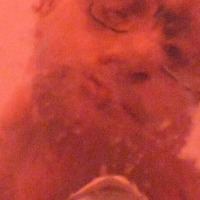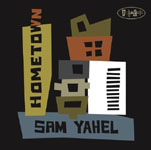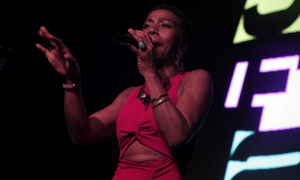Home » Jazz Articles » Live From New York » Pharoah Sanders, Miles From India, Bobby Previte, Marcia...
Pharoah Sanders, Miles From India, Bobby Previte, Marcia Ball, Whitetree & David Grisman
Clearly [Pharaoh Sanders] is in a suitable state to invoke the free jazz storming that made his reputation. With perfect control, he's honking, wailing and blurting, still playing melodically, but taking his toughened tone to the limit.
Birdland
May 26, 2009
How hard does Pharoah Sanders have to try when emanating a spiritual aura? He appears like a natural sage-figure, ambling onstage in an African print shirt, still sporting his distinctive flat-top hair-sculpture, eyes burning with a deep knowledge of jazz's outer (and inner) realms. His last appearance at Birdland found the tenor man in fairly conventional blowing mode, whilst at other gigs Sanders might be playing up to his revered status amongst the jazz-dance crowd, particularly when touring in the UK. He looks like a man who plays what he wants, when the mood is right.
For this late set on the opening night of a six-day run, Sanders is joined by his long-running pianist William Henderson, along with bassman Nat Reeves and drummer Joe Farnsworth. They open with "Happy Birthday" variations for Reeves, who's celebrating on this very day, running through a twisting solo before Sanders abruptly disappears out of the back door. It was the same situation last time he played at this club. Sanders delivers a solo, then retires. Could this be because he's an introverted figure, and doesn't want folks staring at his inactivity? Does he have a range of victuals in the dressing room? Is he going for a lie down? Whatever's the case, it's a most disconcerting habit. David Murray has also started to adopt the same behavior of late. The frequent Sanders disappearance is highly distracting because each time his soloing is followed by a piano exploration, or sometimes a bass rumination, there's a distinct feeling of tension over whether Sanders is going to emerge on time for the next theme section. There's a very real sense that the band is playing for time, as if they too are uncertain. Henderson's first solo is not so much a solo as a massively extended rippling action. Maybe the effect is psychological. If Sanders was present, mulling over each contribution, gauging his re-entry, perhaps we'd feel differently.
Next up is "Ole," and Sanders introduces his first soul-wrenching cry of the set. Clearly he's in a suitable state to invoke the free jazz storming that made his reputation. With perfect control, he's honking, wailing and blurting, still playing melodically, but taking his toughened tone to the limit. This is an unexpected development, but very welcome. Farnsworth is primed for action, swapping between hard and fur-balled sticks, cutting to brushes, sometimes in the midst of a phrase. His accents are unexpected, sharply struck with flashing precision, hi-hat flayed then muted, the underside of his tilted snare tickled and scratched. If we thought that Sanders was in an isolationist mood, this is proved to be not so, as he's now clapping and prompting the audience to sing along. By the time he reaches Coltrane's seminal "Giant Steps," towards the set's close, Sanders has elected to remain out front, statuesquely seated at a frontal table. The number moves so fast, and the solos switch so swiftly, that his action might be required at any moment. Sanders enters his second phase of free-blowing, again with a rock-hewn control. Farnsworth's drum solo here is lengthy, but every moment can be savored, as he's constantly introducing imaginative motifs and contrasting patterns. It seems that a Sanders show is subject to the sensitivities of the evening, but following an uncertain beginning, the entire quartet eventually clicks into magisterial form.
Miles From India
Iridium
May 29, 2009
In May 2008, the Miles From India caravan rolled into New York's Town Hall, presenting a live version of the freshly-released 2-CD project which was viewing the repertoire of Davis from a Subcontinental perspective. The idea was to team some of Miles' old bandmates with a posse of Indian classical players, which wasn't such an alien concept given that the trumpeter had already included such fusions in his multi-faceted music of the late 1960s and early 1970s. That Town Hall show was sometimes hesitant in its unfamiliar construction, made self-conscious by its concert-space setting. This second night of Iridium's run might have a somewhat informal air by comparison, but this roiling looseness is advantageous, recalling how Miles would probably have approached his music back in those untethered dawn-of-fusion days. On the one hand, it sounds like no-one in the band quite knows exactly what's coming next, but on the other mitten, this creates a sense of exciting unpredictability.
The center-stage seated Indian trio have their fingers in their ears (besides already wearing earplugs) as Pete Cosey launches into a cankerous guitar solo, setting out a volume challenge for the rest of the set. This is his payback for being virtually inaudible in the mix at the Town Hall gig. This music features so many inspired contrasts that moments later, the entire band has cut back to feature the soft flute seductions of V.K. Raman. Tablaman Badal Roy and sitarist Hidayat Khan also seize their opportunities for subtle wonderment. At the other end of the scale, it's a source of sheer churning momentum when the twin drummers set up their steaming (on this night it's Ndugu Chancler and Vince Wilburn). The set's highlights are extended versions of "Jean Pierre" and "It's About That Time," with effervescent horn solos delivered in turn by Nicolas Payton (trumpet), Bill Evans and Rudresh Mahanthappa (saxophones). The Miles From India crew can be comfortably at home in a concert hall, but this club setting pulls out a completely different potential of uninhibited improvisation.
Bobby Previte & The New Bump
Blue Note
May 30, 2009
The Blue Note's late night weekend Groove Series mostly revolves around The Funk, as might be expected by its title. New York drummer Bobby Previte is a regular in this slot, but he probably represents its most atypical manifestation. Yes, his New Bump band spends a lot of time creating a rippling pulse, but around half of its set is dedicated to space, quietude and minimalism. What's almost profound is that such a post-midnight, drinking'n'partying crowd can be transfixed into near silence by Previte's musical authority. When the skating beats return, the audience are also switched into head-nodding mode, so The New Bump are obviously masters of both paces. Previte is generating all manner of scissoring beats, but much of the open-ness is a result of Bill Ware's translucent ribboning on the vibraphone. Ellery Eskelin provides the saxophonic bite, and bassist Brad Jones is weaving with serpentine grace throughout. Even though everyone takes solos, these are not clearly delineated, but rise and fall out of the group arrangements, shifting with a waterfall flow. Previte's compositions are frequently pulled towards both throb and shimmer, in a most entrancing manner.
Marcia Ball
B.B. King Blues Club
June 1, 2009
Seems like B.B.'s is a more suitable home for Marcia Ball than the Highline Ballroom, where she played on her last New York visit. That show wasn't lacking in thrust, but the close-packed hardcore blues audience of B.B.'s automatically creates a whooping excitement, which the singer and pianist responds to in an accelerating swoop of energy levels. She's completely in her natural element, holding court with her perpetually cross-legged stance, which makes her appear strangely casual as she's belting out a series of flashy rolls and show-off flourishes. Even though born in Texas, Ball's been fully marinated in Louisiana juices, to the point where she comes across as a genuine native. Her regular combo is still in place, so besides Ball's own soloing prowess, there are running battles between her guitarist and saxophonist, each vying for the place as supreme blaster. The foundation of Ball's approach is a fast-trundlin' boogie woogie blues, but she also rubs in New Orleans jazz, zydeco, swamp pop, rock'n'roll and just about any other Southern form that moves fast enough for her fingers. The stage-flanking vid-screens frequently zoom down on an aerial keyboard view, so all of Ball's speeding runs can be viewed at close range.
Whitetree
(le) Poisson Rouge
June 2, 2009
Who could have imagined such a collaboration? This electro-acoustic trio features Ludovico Einaudi working with two-thirds of To Rococo Rot. The Italian pianist Einaudi has traditionally emanated an aura of coffee table sophistication, oft appreciated by those kind of folks who don't actually like music. Or at least the kind of music that troubles the eardrums. Meanwhile, the German electronicists To Rococo Rot operate in a completely different sonic sphere, of spliced glitchery and jerky danceability. Basically, their records used to be scattered across the chaos of hipster dens, as opposed to being carefully arranged on symmetrically aligned daises within sanctums of tastefulness. This is not a musical meeting that would have featured in the dreams of many. Onstage, for their first US gig, it's easy to view the Whitetree proceedings through unbiased peepers, free of any admitted preconceptions. Even though their mechanoid progressions don't claw at the sonic veil, such transgressive friction is probably not desired. The Whitetree approach is concerned with gentle pulse-development and steady unwindings, like the careful dismantling of pocket watch innards. This Italo-German alliance can't help but be punctual.
The crowd isn't as swollen as expected, but Einaudi's superstar status is more of a European phenomenon, and he'd only made his US touring debut towards the end of 2008. Drummer Ronald Lippok has a careful way with building his cycles, all the more notable if the viewer is situated at his feet. He'll use brushes with massive restraint, setting up a steady metronome swish, gradually introducing each element of the drum-set, until right at the climax of an admittedly stately piece he might trip the bass drum pedal, just when the onlooker is literally begging for the fuller beat to kick in. Such restraint and attention to layering is what helps create a strange kind of tension, as Einaudi and Ronald's brother Robert are sensitively shaping the relationship of acoustic piano and softened electronic patterns. Einaudi is the personification of ripple. Whitetree's music is certainly not innovative, but it does possess an inviting atmosphere of rolling organic development, steadily sowing grains of pleasure out amongst its listeners. Both factions may have problems with magnetising their established followings, but perhaps the governing idea is to create a completely new congregation.
The David Grisman Quintet
B.B. King Blues Club
June 3, 2009
Mandolin man Grisman's band has a jazz configuration, but his prime genre has always been bluegrass. Possibly. Even though old-time picking can't help but inform every note of his set, the repertoire isn't exactly either form, and manages to ensnare elements from a variety of rootsy sources, ending up with what Grisman has (for almost four decades) been terming dawg music. Indeed, his website is www.dawgnet.com. The last time Grisman played at B.B.'s, the tunes felt more ingrained with the bluegrass spirit, but on this visit he's definitely out there, dodging between the categories. Even though there's no shortage of dexterously pinging mandolin solos, the multi-flute mastery of Matt Eakle is a major part of the sound, his hard-edged, percussive approach side-stepping all of the usual jazz cliches that have been established for his instrument (let that bass flute belch!). The quintet has been together for over thirty years, but Grisman jokes that he's the only original member. Even so, the current model has already built up a heady rapport (though bassist Jim Kerwin has been with Grisman for around two of those decades). It's a show with humor, dash and virtuosity, an exhilarating adventure into musical miscegenation.
Tags
PREVIOUS / NEXT
Support All About Jazz
 All About Jazz has been a pillar of jazz since 1995, championing it as an art form and, more importantly, supporting the musicians who make it. Our enduring commitment has made "AAJ" one of the most culturally important websites of its kind, read by hundreds of thousands of fans, musicians and industry figures every month.
All About Jazz has been a pillar of jazz since 1995, championing it as an art form and, more importantly, supporting the musicians who make it. Our enduring commitment has made "AAJ" one of the most culturally important websites of its kind, read by hundreds of thousands of fans, musicians and industry figures every month.



































